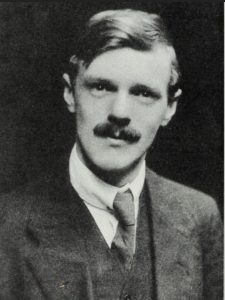53 Biography: D. H. Lawrence
Portrait of D. H. Lawrence
Artist | Unknown Source | Wikimedia Commons License | Public Domain
D. H. LAWRENCE
(1885-1930)
David Herbert Lawrence was born in Eastwood, Nottinghamshire, where his father Arthur John Lawrence labored as a coal miner. His mother Lydia Lawrence, a well-educated and literary woman from a middle-class family, inspired Lawrence’s interest in literature. She also highlighted his lifelong conflict with the labor industry and class system in England. His father’s work in the coal mine, from which daily he would almost symbolically emerge blackened by the coal, helped inspire Lawrence’s interest in essential, core identity and the unconscious.
Despite almost chronic illness and being at odds with his environment, Lawrence earned a scholarship to the Nottingham High School. After graduating, he worked at the British School in Eastwood, where he met Jessie Chambers who encouraged his intellectual and literary pursuits, especially his writing. In 1908, he obtained a teaching certificate from the University College of Nottingham then went on to teach at an Elementary school in London.
Jessie Chambers sent three of Lawrence’s poems to Ford Madox Hueffer (later Ford Madox Ford) (1873-1939), editor of The English Review. He published them and saw to Lawrence’s introduction to the London literary scene. Upon Hueffer’s recommendation of Lawrence’s short story “Odour of Chrysanthemums,” William Heinemann published Lawrence’s first novel, The White Peacock (1910). Autobiographical like much of Lawrence’s work, The White Peacock depicts his relationship with Jessie Chambers, who also appeared as Miriam in his Sons and Lovers (1913).
The mother in Sons and Lovers is closely based upon Lydia Lawrence who grew to disdain what she viewed as her husband’s coarseness and brutality and who transferred her affection, to an overwhelming degree, to her sons. Marital unhappiness recurs in The Rainbow (1915), whose Tom Brangwen marries the non-British Lydia Lensky. Lawrence himself, after having been engaged to childhood friend Louie Burrows, fell in love with Frieda von Richthofen Weekley (1879-1956), distant cousin of Manfred von Richthofen (aka The Red Baron), wife of Lawrence’s Nottingham College German tutor, and mother of three children. Her reciprocal passion for Lawrence led the two to elope to the Continent. In 1914 after her divorce, she and Lawrence returned to England and married.
Lawrence’s growing discontent with western civilization, particularly England, was exacerbated by the harassment he and his wife received during England’s war with Germany in WWI, at the end of which he and Frieda left England for the remainder of Lawrence’s life (they returned twice only briefly). Also hindering was the censorship of his novels, beginning with The Rainbow. The sexual explicitness of Lawrence’s novels, an explicitness culminating most notoriously in Lady ChatterlyS Lover (1928), elucidates Lawrence’s evolving mythos that he articulates in Psychoanalysis and the Unconscious (1922) and Fantasia of the Unconscious (1922) and later in his pagan/Druid poems. Lawrence criticized what he saw as the errors of modern civilization, to the point of harboring apocalyptic visions with a smash up of the human world to make way for better, more expressive species.
Like T. S. Eliot, Lawrence deplored the tendency of modern human beings to put their energies into their heads, to experience their sexuality vicariously rather than directly. He advocated instead connections, of the reason and the unconscious, mind and body, man and woman, human and nature, sky and earth. He thought the individual needed personal integrity and inter-relatedness, needed to balance forces of attraction and repulsion, sympathy and volition both within themselves and with the world around them. For Lawrence, relationships of man and woman (as well as humans with nature and vice versa) helped to realize the individual’s core identity in the face of industrialization and institutionalized religion, helped individuals get outside of themselves to the vital, quick forces of humankind and life itself.
Lawrence continued to philosophize and mythologize in his writing until he died of tuberculosis at the age of forty-four.
This material is from British Literature II: Romantic Era to the Twentieth Century and Beyond by Bonnie J. Robinson from the University System of Georgia, which is licensed under a Creative Commons Attribution-ShareAlike 4.0 International License.
This license allows you to remix, tweak, and build upon this work, even commercially, as long as you credit this original source for the creation and license the new creation under identical terms.

